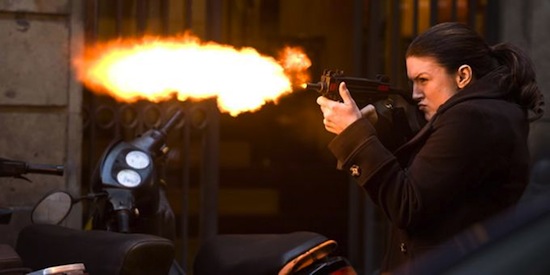Soderbergh's strongest talent, it seems, is in his assembly of high-talent actors to star in all of his films. From Traffic to Contagion to Ocean's 11, Soderbergh has proven himself the master of the ensemble cast. However, recently Soderbergh has gone specifically out of his way to blend the lines between reality and fiction in his more focused casting. This was most notable with his casting of porn star Sasha Grey in his film The Girlfriend Experience, where she starred as a high-end Manhattan prostitute.
In his newest film, Haywire, Soderbergh attempts to bring the same realism to his protagonist's performance that Sasha Grey, in her controversial role, brought to The Girlfriend Experience. This time he has brought in celebrated MMA (mixed martial arts) fighter Gina Carano to play the powerful black-ops operative Mallory Kane. Has casting an untested actress for her raw physicality paid off for Soderbergh in Haywire?
Carano's unblinking stare and deadpan delivery might not impress immediately, but her beautiful, granite physique says everything that her dialogue does not. Haywire could have very easily have been a feminist film about the raw power of a woman, and it might still be. However, Carano is such a powerhouse that she single-handedly deflects this notion. Instead, all of the men in the film feel like slight distractions, mere speedbumps, on the way to her ultimate goal.
While Carano's performance isn't entirely convincing, it isn't what causes Haywire to suffer. It is this ultimate goal of Carano's Mallory and the method of storytelling that in the end robs Haywire of its punch and emotional tangibility.
Soderbergh reveals his hand in the first scene of Haywire, as the audience gets to watch Mallory take down her former partner Aaron (Channing Tatum) in a remote diner. The scene is a proof of concept on the casting of Gina Carano. To see Carano easily toss around a lug of a man like Channing Tatum is a real spectacle, one that even Channing's character doesn't expect.
Mallory has been betrayed by her former employers and, just like the audience, she doesn't know why. The idea of a spy left out in the cold isn't a new one and would would have worked fine here in Haywire if the audience was given a reason to fully invest in the concept. Mallory's dispassionate persona keeps the audience alienated and with no real sense of why she has been betrayed it is hard to care for whether or not she is successful.
Writer Lem Dobbs, who previously worked with Soderbergh on the excellent The Limey, tries to alleviate this situation by having Mallory explain her history with her employer through a series of flashbacks. The initial problem with this idea is that Mallory is explaining her story to a random guy she grabbed from the diner to sew up her injured arm. The reasoning for her expository story. of how she is a super-spy. to this hastily snatched individual is never explained and it serves as a huge hole in the wall between viewer and storyteller.
It is only towards the end of the film that the audience is given a glimpse at Mallory's heart and a truer look at how she became the woman that she is. However, it is far too late and short to truly inspire any reason to care about or her ambiguous goals.
Soderbergh's eccentric sense of style and structure is on full display in Haywire, often drowning out the fantastic physical work done by Carano. A rescue/chase scene early in the film is completely muted, allowing the incredible score by David Holmes to drive the action. The score is beautiful and very reminiscent of the progressive jazz tones used to drive the fun tone of the Ocean's films. In this case, the exclusion of diegetic sounds removes any sense of geography and cohesion from the already narratively confusing scene, leaving the audience to be bludgeoned by the score into a state of numb submission.
The exact opposite can be said of Haywire's best scenes, where the diegetic sounds dominate the soundtrack and the visual geography is crystal clear. Every time Carano is allowed to fill the screen with her one-on-one action the film is a breathtaking display of the elegance of combat. Carano's MMA background is apparent in every spectacular move she makes, particularly in a mid-movie fight with the sneering Fassbender that draws a comparison between a good fight and a good lay. Soderbergh pulls back the camera to allow the action to play out without any obstruction. Each punch registers as a result, allowing the visceral pain and physicality of the fight to jump out of the screen.
It is a shame that their aren't more fights like this in Haywire, as they are not only the best part of the film but also the reason why Carano was hired in the first place. In its place is a convoluted storyline that places its weight on the acting skills of the untested Carano, who does a fine enough job but doesn't have the acting chops to carry an entire film.
Much like Soderbergh's directorial stylings, Haywire is a film to turn on while listening to smooth jazz; its story and visuals rush past with only slight memorable punctuations.
 |
| 2.5 / 4 Reels |




Nice write-up. This spy flick actually features some great fight scenes and stunt. It is edited right down to the bone and the production is about as slick as anything in recent years. Emotionally, however, it is on the cold side, mainly because of Carano's stiff-delivery.
ReplyDelete